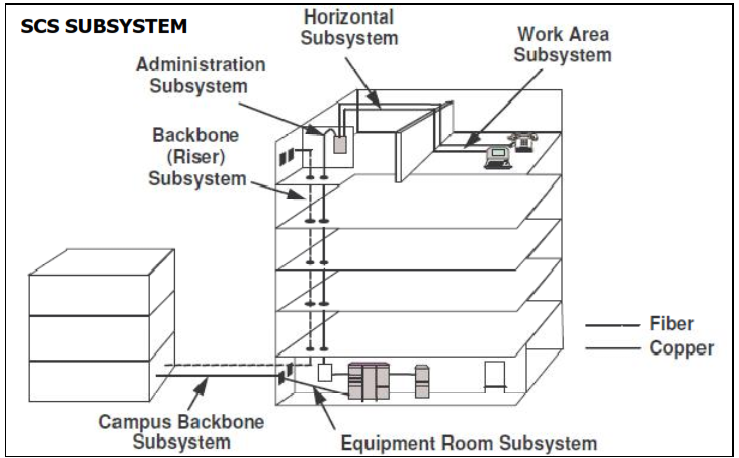In telecommunications, structured cabling is building or campus cabling infrastructure that consists of a number of standardized smaller elements called subsystems. Structured cabling components include twisted pair and optical cabling, patch panels and patch cables. Source by Wikipedia
Structured Cabling Design, Architectural and Environmental Considerations
The design of a structured cabling system must meet the individual or combined voice, data and video requirements from a customer. A well planned structured cabling system design is capable of supporting the customer’s changing application needs without requiring major modifications.
By using the Design Guidelines contained in this document, a structured cabling system can serve most voice, data, and video applications. There is also the flexibility to customize the design to meet unique customer requirements.

This document contains design information for all subsystems except the Work Area. The design of the Work Area portion of the cabling system is application specific.
Structured Cabling Architectural Consideration
The design process for a proposed building requires the SCS designer to ideally provide an architect with recommendations for the telecommunications infrastructure in a building that has not yet been constructed. These recommendations include the sizing and location of the following:
• Equipment rooms
• Telecommunication closets
• Media distribution systems
For an existing building, the designer assures that the building has a telecommunications infrastructure design which includes similar to the above.
This requires that the SCS designer identify the existing telecommunications infrastructure and recommend modifications to that infrastructure as specified in an RFP/RFQ.
Structured Cabling Design Consideration
A prime consideration in any building plan has to be the protection of personnel and equipment from electrical shock and fire hazards. In most of the countries, construction is regulated by building and electrical codes that are strictly enforced by government and local agencies. Usually, local electrical codes follow national standards, such as the National Electrical Code (NEC) in the US, which covers requirements for communications wiring in relation to power wiring. These codes often deal with such particulars as:
• The spacing between electrical and communications wires
• Insulation, protection requirements for exposed wire pairs
• Grounding and bonding.
An SCS designer needs to be aware of relevant local codes which may take precedent over the national and international codes.
Structured Cabling Environmental Considerations
The design of a structured cabling system must meet the individual or combined voice, data and video requirements from a customer. A well planned structured cabling system design is capable of supporting the customer’s changing application needs without requiring major modifications.
The major steps in the cabling design start-up procedure require the SCS designer to:
- Evaluate the customers’ communications needs.
- Evaluate the physical building or campus environment in which facilities are to be placed.
- Determine the suitable communications network design and media to be used:
- Fiber/Copper (integrated)
- Fiber (only)
- Copper (only)
- Communicate the preliminary system design and estimated cost to the customer or end-user contact group.
Telecommunications Infrastructure Design Process
Sources of Electromagnetic Interference EMI in Structured Cabling
Media Distributing Methods for Structured Cabling Design
How corrosion Occurs in Structured Cabling
Impedance Characteristics in Structured Cabling